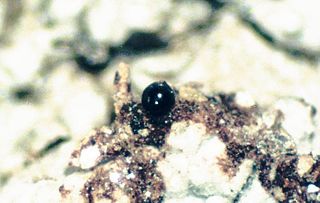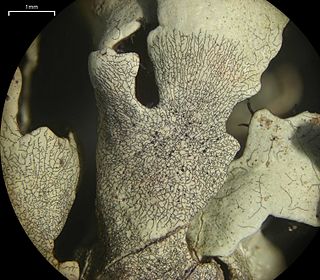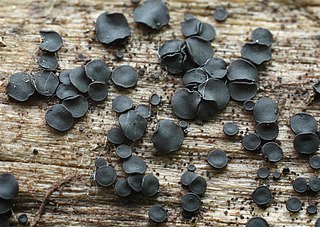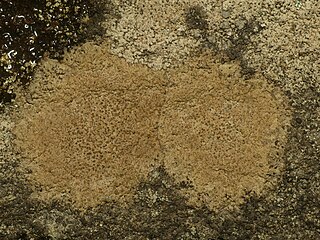
The Coccotremataceae are a family of lichen-forming fungi in the order Pertusariales. Species in this widely distributed family grow on bark or rocks, especially in maritime regions.

Erioderma is a genus of lichen-forming fungi in the family Pannariaceae. They are commonly called mouse ears or felt lichens, and are small, pale brown to olive-brown foliose cyanolichens with a fuzzy upper surface that have the cyanobacteria Scytonema as their photobiont. Most species are found in the tropics of Central and South America, although three species are found in coastal regions of North America where they generally grow on mossy branches in humid sites. All North American species are rare. Species of Erioderma can resemble Pannaria, Leioderma, or small Peltigera, but their fuzzy upper surface and lack of veins on their lower surface distinguishes them from these lichens.

Diploicia is a genus of lichenized fungi in the family Caliciaceae. The genus has a widespread distribution, especially in temperate regions, and contains 6 species.
Combea is a genus of lichens in the family Opegraphaceae. It has two species. The genus was circumscribed by Italian botanist Giuseppe De Notaris in 1846.
Merismatium is a genus of lichenicolous (lichen-dwelling) fungi of uncertain familial placement in the order Verrucariales. The genus was circumscribed in 1898 by Friedrich Wilhelm Zopf.

The Meliolaceae are a family of fungi in the order Meliolales. Mostly tropical in distribution, species in this family are biotrophic on the leaves and stems of plants. Despite this, most species do not cause extensive damage to the host plant, and are not generally considered to be of economic significance.
The Asterinaceae are a family of fungi in the class Asterinales.

Xylobotryum is a genus of fungi in the Ascomycota phylum and in the order of Xylobotryales.

Ephebe is a genus of lichen in the family Lichinaceae.

Sphinctrina is a genus of lichenicolous fungi, usually not lichenized, in the family Sphinctrinaceae. Its species are most commonly parasitic on lichens of the genus Pertusaria.
Cryptodiscus is a genus of lichen-forming fungi in the family Stictidaceae.
Arctomia is a genus of lichen-forming fungi in the family Arctomiaceae. The genus was originally circumscribed by Theodor Magnus Fries in 1861. Arctomia has a circumpolar distribution.

Bulgaria is a genus of fungi in the family Phacidiaceae. The genus was circumscribed in 1822 by Elias Magnus Fries, with Bulgaria inquinans assigned as the type species.
Serenomyces is a genus of fungi within the family Phaeochoraceae.

Baeomyces is a genus of lichenized fungi in the family Baeomycetaceae. Members of Baeomyces are commonly called cap lichens. The genus was circumscribed by German mycologist Christiaan Hendrik Persoon in 1794. Although Persoon did not designate a type species in his original description of the genus, Frederick Clements and Cornelius Lott Shear assigned Baeomyces byssoides as the type in 1931.

Caliciales is an order of mostly lichenized fungi in the class Lecanoromycetes. It consists of two families: Caliciaceae and Physciaceae, which together contain 54 genera and more than 1200 species. The order was circumscribed by American botanist Charles Edwin Bessey in 1907.

Lichenoconium is a genus of fungi belonging to the family Lichenoconiaceae.

Lichenostigmatales is an order of fungi in the class Arthoniomycetes. It contains the single family Phaeococcomycetaceae. Lichenostigmatales was circumscribed in 2014 by Damien Ertz, Paul Diederich, and James D. Lawrey, with genus Lichenostigma assigned as the type. Using molecular phylogenetics, they identified a lineage of taxa in the Arthoniomycetes that were phylogenetically distinct from the order Arthoniales. Species in the Lichenostigmatales include black yeasts, lichenicolous, and melanised rock-inhabiting species.

Patellaria is a genus of fungi in the family Patellariaceae. The genus was circumscribed in 1822 by mycologist Elias Magnus Fries with Patellaria atrata assigned as the type species.

Ionaspis is a genus of lichen-forming fungi in the family Hymeneliaceae. It contains six species of saxicolous (rock-dwelling), crustose lichens. The genus was originally circumscribed in 1871 by Theodor Magnus Fries. He segregated the genus from Aspicilia based on the presence of Trentepohlia rather than Trebouxia as the photobiont partner.














